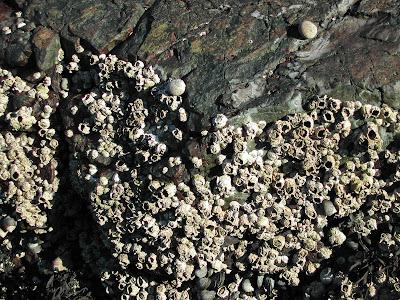Referrences:Wikipedia
Edited by:Ummu Syauqina Nurharyati Husna
An aquatic ecosystem is an ecosystem located in a body of water. Communities of organisms that are dependent on each other and on their environment live in aquatic ecosystems. The two main types of aquatic ecosystems are marine ecosystems and freshwater ecosystems.
Main article: Marine ecosystem
Marine ecosystems cover approximately 71% of the Earth's surface and contain approximately 97% of the planet's water. They generate 32% of the world's net primary production.
They are distinguished from freshwater ecosystems by the presence of dissolved compounds, especially salts, in the water. Approximately 85% of the dissolved materials in seawater are sodium and chlorine. Seawater has an average salinity of 35 parts per thousand (ppt) of water. Actual salinity varies among different marine ecosystems.
Marine ecosystems can be divided into the following zones: oceanic (the relatively shallow part of the ocean that lies over the continental shelf); profundal (bottom or deep water); benthic (bottom substrates); intertidal (the area between high and low tides); estuaries; salt marshes; coral reefs; and hydrothermal vents (where chemosynthetic sulfur bacteria form the food base).
Classes of organisms found in marine ecosystems include brown algae, dinoflagellates, corals, cephalopods, echinoderms, and sharks. Fish caught in marine ecosystems are the biggest source of commercial foods obtained from wild populations.
Environmental problems concerning marine ecosystems include unsustainable exploitation of marine resources (for example overfishing of certain species), marine pollution, climate change, and building on coastal areas.
Freshwater
Main article: Freshwater ecosystem
Freshwater ecosystems cover 0.8% of the Earth's surface and contain 0.009% of its total water. They generate nearly 3% of its net primary production.
Freshwater ecosystems contain 41% of the world's known fish species.
There are three basic types of freshwater ecosystems:
Lentic: slow-moving water, including pools, ponds, and lakes.
Lotic: rapidly-moving water, for example streams and rivers.
Wetlands: areas where the soil is saturated or inundated for at least part of the time.
Lake ecosystems can be divided into zones: pelagic (open offshore waters); profundal; littoral (nearshore shallow waters); and riparian (the area of land bordering a body of water).
Two important subclasses of lakes are ponds, which typically are small lakes that intergrade with wetlands, and water reservoirs. Many lakes, or bays within them, gradually become enriched by nutrients and fill in with organic sediments, a process called eutrophication. Eutrophication is accelerated by human activity within the water catchment area of the lake.
Freshwater ecosystem.
The major zones in river ecosystems are determined by the river bed's gradient or by the velocity of the current. Faster moving turbulent water typically contains greater concentrations of dissolved oxygen, which supports greater biodiversity than the slow moving water of pools.
These distinctions forms the basis for the division of rivers into upland and lowland rivers. The food base of streams within riparian forests is mostly derived from the trees, but wider streams and those that lack a canopy derive the majority of their food base from algae. Anadromous fish are also an important source of nutrients. Environmental threats to rivers include loss of water, dams, chemical pollution and introduced species.
Wetlands are dominated by vascular plants that have adapted to saturated soil. Wetlands are the most productive natural ecosystems because of the proximity of water and soil. Due to their productivity, wetlands are often converted into dry land with dykes and drains and used for agricultural purposes. Their closeness to lakes and rivers means that they are often developed for human settlement.
Main article: Pond
These are a specific type of freshwater ecosystems that are largely based on the autotroph algae which provide the base trophic level for all life in the area. The largest predator in a pond ecosystem will normally be a fish and in-between range smaller insects and microorganisms. It may have a scale of organisms from small bacteria to big creatures like water snakes, beetles, water bugs, frogs, tadpoles, and turtles. This is important for the environment.
Aquatic ecosystems perform many important environmental functions. For example, they recycle nutrients, purify water, attenuate floods, recharge ground water and provide habitats for wildlife.
Aquatic ecosystems are also used for human recreation, and are very important to the tourism industry, especially in coastal regions.
The health of an aquatic ecosystem is degraded when the ecosystem's ability to absorb a stress has been exceeded. A stress on an aquatic ecosystem can be a result of physical, chemical or biological aterations of the environment. Physical alterations include changes in water temperature, water flow and light availability. Chemical alterations include changes in the loading rates of biostimulatory nutrients, oxygen consuming materials, and toxins. Biological alterations include the introduction of exotic species. Human populations can impose excessive stresses on aquatic ecosystems.
Abiotic characteristics
An ecosystem is composed of biotic communities and abiotic environmental factors, which form a self-regulating and self-sustaining unit. Abiotic environmental factors of aquatic ecosystems include temperature, salinity, and flow.
The amount of dissolved oxygen in a water body is frequently the key substance in determining the extent and kinds of organic life in the water body. Fish need dissolved oxygen to survive. Conversely, oxygen is fatal to many kinds of anaerobic bacteria.
The salinity of the water body is also a determining factor in the kinds of species found in the water body. Organisms in marine ecosystems tolerate salinity, while many freshwater organisms are intolerant of salt. Freshwater used for irrigation purposes often absorb levels of salt that are harmful to freshwater organisms.Though some salt can be good for organisms.
Biotic characteristics
The organisms (also called biota) found in aquatic ecosystems are either autotrophic or heterotrophic.
Autotrophic organisms
Autotrophic organisms are producers that generate organic compounds from inorganic material. Algae use solar energy to generate biomass from carbon dioxide and are the most important autotrophic organisms in aquatic environments.
Chemosynthetic bacteria are found in benthic marine ecosystems. These organisms are able to feed on hydrogen sulfide in water that comes from volcanic vents. Great concentrations of animals that feed on this bacteria are found around volcanic vents. For example, there are giant tube worms (Riftia pachyptila) 1.5m in length and clams (Calyptogena magnifica) 30cm long.
Heterotrophic organisms
Heterotrophic organisms consume autotrophic organisms and use the organic compounds in their bodies as energy sources and as raw materials to create their own biomass.
Euryhaline organisms are salt tolerant and can survive in marine ecosystems, while stenohaline or salt intolerant species can only live in freshwater environments.



































